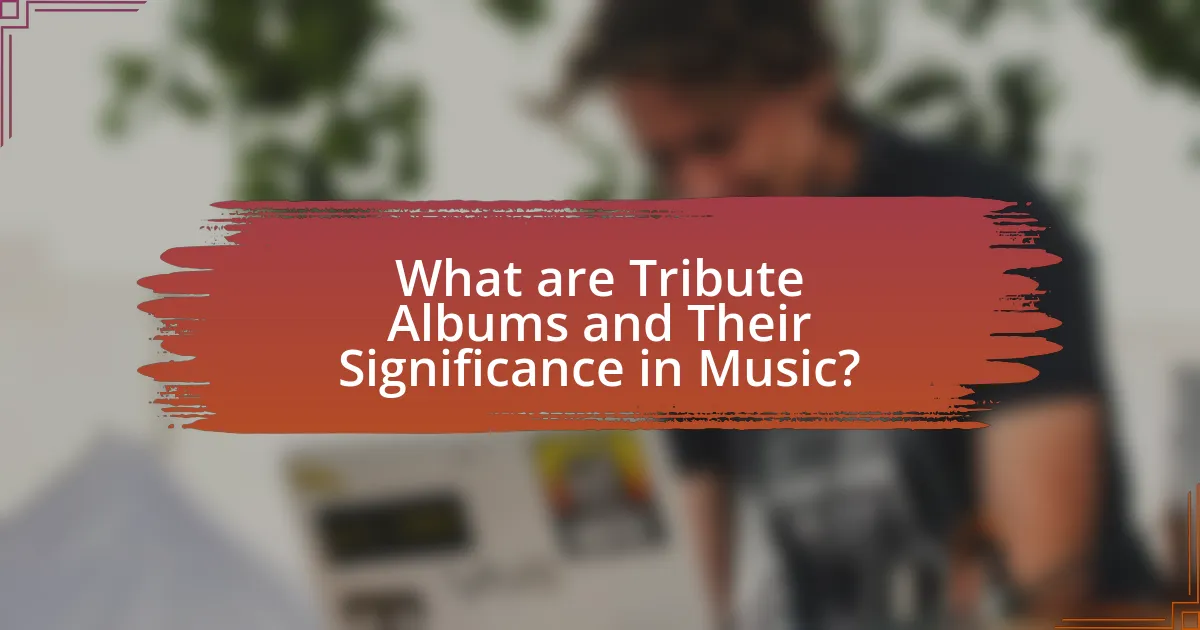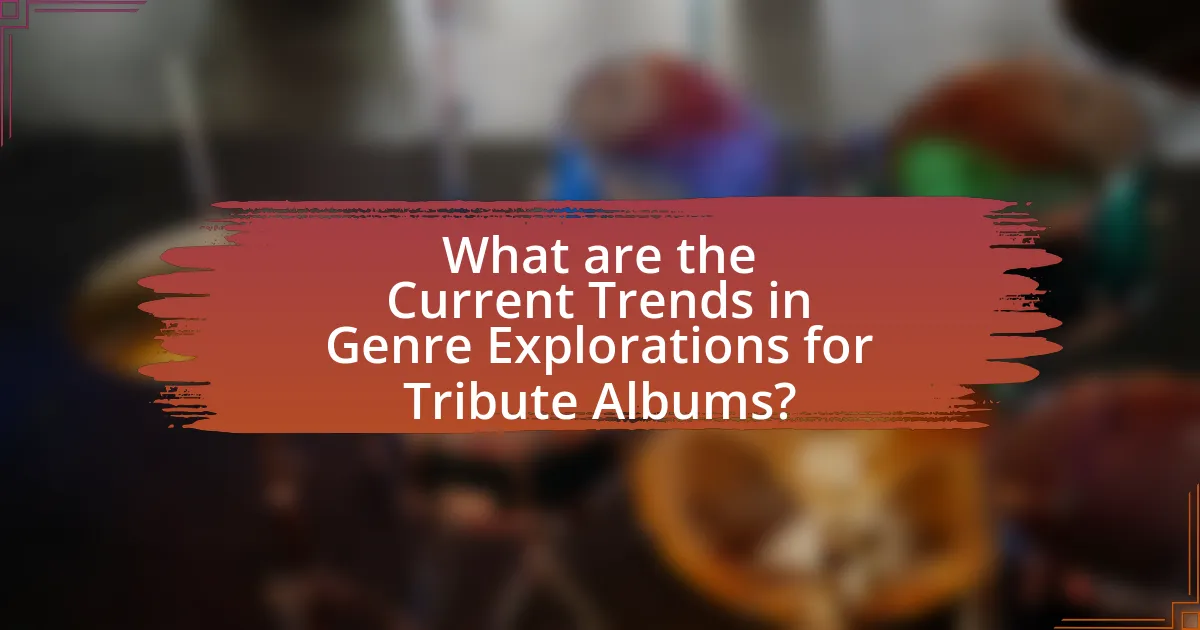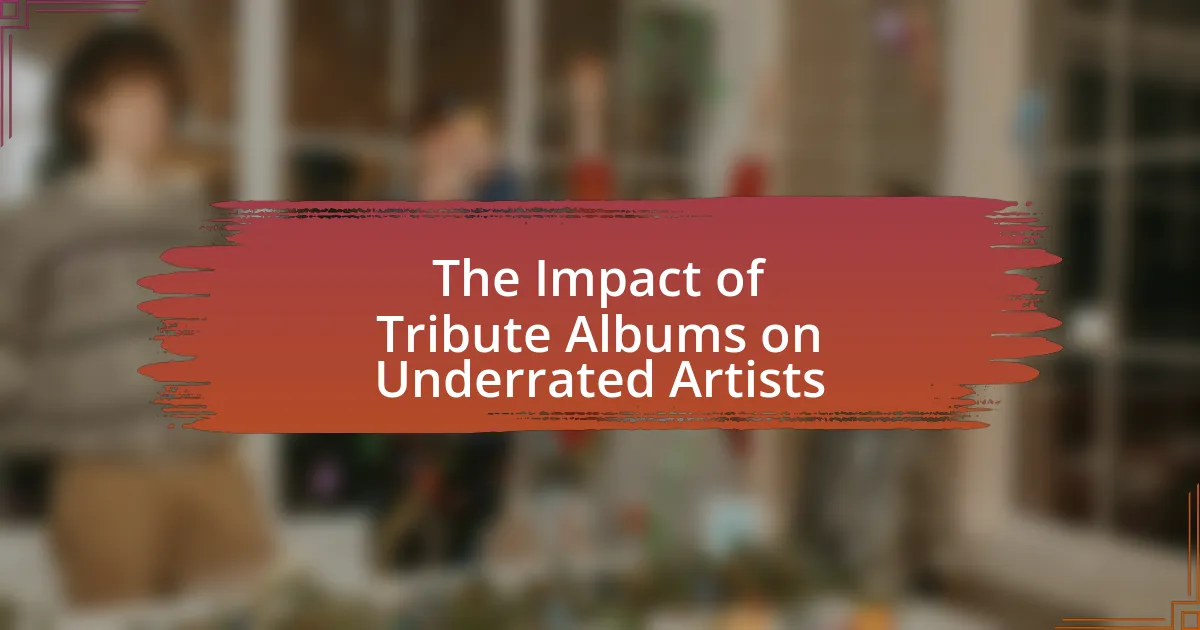Tribute albums are collections of songs that honor specific artists, bands, or musical genres, featuring various artists reinterpreting original works. They play a significant role in celebrating the influence of the honored musicians, introducing their music to new audiences, and fostering collaboration among contemporary artists. The article explores the significance of tribute albums, how they honor original artists, common elements included, and the motivations behind their creation. It also examines trends shaping their evolution, the impact of musical genres and technology, and predictions for the future, including the rise of cross-genre collaborations and the influence of emerging artists. Additionally, it addresses the challenges tribute albums may face in an evolving music industry landscape.

What are Tribute Albums and Their Significance in Music?
Tribute albums are collections of songs that pay homage to a specific artist, band, or musical genre, featuring various artists performing the original works. Their significance in music lies in their ability to celebrate the influence of the honored musicians, introduce their music to new audiences, and foster collaboration among contemporary artists. For instance, the tribute album “The Bridge: A Tribute to Neil Young” showcases various artists interpreting Young’s songs, thereby highlighting his impact on rock music and ensuring his legacy endures. Additionally, tribute albums often serve as a platform for emerging artists to gain exposure while connecting with the established music community.
How do Tribute Albums honor original artists?
Tribute albums honor original artists by reinterpreting their music through the performances of various artists, thereby celebrating the original works and their cultural significance. These albums often feature covers of iconic songs, allowing new generations to experience the original artist’s influence while showcasing the versatility and enduring appeal of their music. For instance, the tribute album “The Art of McCartney” includes covers of Paul McCartney’s songs by various artists, demonstrating how his work continues to inspire and resonate within the music community. This practice not only pays homage to the original artists but also introduces their music to a wider audience, ensuring their legacy endures.
What elements are commonly included in a Tribute Album?
A tribute album commonly includes cover songs, which are reinterpretations of original tracks by various artists, honoring the work of a specific musician or band. Additionally, tribute albums often feature a diverse range of artists, showcasing different musical styles and interpretations, which can enhance the emotional connection to the original material. Many tribute albums also include liner notes or essays that provide context about the artist being honored, as well as the significance of the songs chosen. Furthermore, some tribute albums may incorporate previously unreleased tracks or live recordings to offer fans unique content related to the original artist.
Why do artists choose to create Tribute Albums?
Artists choose to create tribute albums to honor influential musicians and their contributions to music. This practice allows artists to pay homage while also introducing the original works to new audiences. Tribute albums often serve as a means of artistic expression, enabling musicians to reinterpret and reimagine classic songs in their unique styles. Additionally, these albums can foster community within the music industry, as various artists collaborate to celebrate a shared legacy. The commercial success of tribute albums, evidenced by notable releases like “The Tribute to Johnny Cash” and “We Are the World,” further demonstrates their appeal and significance in the music landscape.
What trends have shaped the evolution of Tribute Albums?
The evolution of tribute albums has been shaped by several key trends, including the rise of nostalgia, genre blending, and the influence of digital platforms. Nostalgia drives artists and fans to celebrate iconic musicians and eras, leading to the creation of tribute albums that honor past legends, such as “The Tribute to Johnny Cash” album released in 2010, which featured contemporary artists covering his songs. Genre blending has also become prominent, as seen in albums like “The Metallica Blacklist,” where various artists from different genres reinterpret Metallica’s classic tracks, showcasing the versatility of the original music. Additionally, digital platforms have facilitated the accessibility and distribution of tribute albums, allowing for a wider audience reach and the emergence of independent tribute projects, as evidenced by the success of online crowdfunding campaigns for tribute albums. These trends collectively illustrate how tribute albums have evolved to reflect cultural shifts and technological advancements in the music industry.
How have musical genres influenced Tribute Album styles?
Musical genres have significantly influenced tribute album styles by dictating the arrangement, instrumentation, and overall sound of the covers. For instance, tribute albums dedicated to rock bands often feature electric guitars and a heavier sound, while those honoring pop artists may incorporate synthesizers and upbeat tempos. This genre-specific approach allows tribute albums to resonate with the original artist’s fan base while also attracting new listeners.
Moreover, the diversity of genres has led to innovative interpretations; for example, a tribute album to a classic rock band might include renditions in jazz or country styles, showcasing the versatility of the original music. This trend is evident in albums like “The Metallica Blacklist,” which features various artists from different genres reinterpreting Metallica’s songs, thus highlighting how genre influences the creative direction of tribute projects.
What role does technology play in the production of Tribute Albums?
Technology plays a crucial role in the production of tribute albums by enabling high-quality sound recording, editing, and distribution. Advanced digital audio workstations allow producers to manipulate sound with precision, ensuring that tribute tracks closely resemble the original works while incorporating modern elements. Additionally, technology facilitates collaboration among artists across different locations through cloud-based platforms, enhancing creativity and diversity in tribute album production. The use of streaming services and social media for promotion further amplifies the reach of tribute albums, allowing them to connect with wider audiences.
What predictions can be made about the future of Tribute Albums?
The future of tribute albums is likely to see an increase in genre diversity and innovative collaborations. As artists continue to explore various musical styles, tribute albums will reflect a broader range of influences, appealing to diverse audiences. For instance, the rise of genre-blending in contemporary music suggests that tribute albums will increasingly feature cross-genre interpretations, similar to how recent projects have combined rock with hip-hop or electronic elements. Additionally, the growing trend of digital platforms allows for easier access and distribution, which may lead to more frequent releases and niche tributes that cater to specific fan bases. This evolution is supported by the success of recent tribute albums that have garnered critical acclaim and commercial success, indicating a sustained interest in honoring musical legacies through fresh interpretations.
How might genre explorations expand in upcoming Tribute Albums?
Genre explorations in upcoming Tribute Albums may expand through the incorporation of diverse musical styles and cross-genre collaborations. This trend is evidenced by recent tribute projects that blend genres, such as the “Lilith Fair: A Celebration of Women in Music” album, which featured artists from various genres, showcasing how different musical influences can coexist. Additionally, the rise of digital platforms allows for greater accessibility and experimentation, enabling artists to draw inspiration from a wider array of genres, thus enriching the tribute album landscape.
What emerging artists are likely to influence future Tribute Albums?
Emerging artists likely to influence future tribute albums include Billie Eilish, Lil Nas X, and Hozier. Billie Eilish’s innovative approach to pop music and her ability to connect with younger audiences position her as a significant influence. Lil Nas X’s genre-blending style and cultural impact have already reshaped the music landscape, making him a key figure for future tributes. Hozier’s soulful sound and lyrical depth resonate with a wide audience, suggesting that his work will inspire future tribute projects. These artists are shaping contemporary music trends, which will likely be reflected in upcoming tribute albums.
How do Tribute Albums impact the music industry?
Tribute albums significantly impact the music industry by revitalizing interest in original artists and introducing their music to new audiences. These albums often feature contemporary artists covering classic songs, which can lead to increased sales and streaming of the original works. For instance, the tribute album “We Are the World” not only raised funds for humanitarian efforts but also boosted the careers of many artists involved, demonstrating how tribute projects can create a resurgence in popularity for both the original and covered songs. Additionally, tribute albums can foster genre exploration, as they encourage artists to reinterpret songs in different styles, thereby expanding the musical landscape and influencing trends within the industry.
What are the potential challenges facing Tribute Albums in the future?
Tribute albums face several potential challenges in the future, including market saturation, diminishing consumer interest, and the evolving landscape of music consumption. Market saturation occurs as numerous tribute albums flood the market, making it difficult for new releases to stand out. Diminishing consumer interest is evident as audiences increasingly seek original content rather than reinterpretations of existing works. Additionally, the shift towards streaming services and digital platforms alters how tribute albums are marketed and consumed, potentially reducing their visibility and profitability. These factors collectively threaten the viability and relevance of tribute albums in an ever-changing music industry.

What are the Current Trends in Genre Explorations for Tribute Albums?
Current trends in genre explorations for tribute albums include a significant rise in cross-genre collaborations and the incorporation of diverse musical styles. Artists are increasingly blending genres, such as rock with hip-hop or country with electronic music, to create unique interpretations of classic songs. This trend is supported by the growing popularity of genre-bending artists and the demand for fresh takes on familiar tracks, as evidenced by recent tribute albums that feature a mix of established and emerging artists from various musical backgrounds. Additionally, there is a notable emphasis on cultural representation, with tribute albums celebrating artists from different ethnic backgrounds and genres, reflecting a broader societal push for inclusivity in music.
How are cross-genre collaborations shaping Tribute Albums?
Cross-genre collaborations are significantly shaping tribute albums by introducing diverse musical styles and broadening the appeal of the original works. These collaborations allow artists from different genres to reinterpret classic songs, creating fresh sounds that attract new audiences. For instance, the tribute album “We Are the 21st Century Ambassadors of Peace & Magic” features artists from various genres, showcasing how blending styles can revitalize the original material. This trend not only honors the legacy of the original artists but also fosters innovation in music, as seen in projects like “The Metallica Blacklist,” where artists from pop, country, and metal genres contribute their unique takes on Metallica’s songs. Such cross-genre efforts enhance the cultural relevance of tribute albums, making them more dynamic and engaging for listeners.
What examples illustrate successful cross-genre Tribute Albums?
Successful cross-genre tribute albums include “The Metallica Blacklist,” which features artists from various genres covering songs from Metallica’s self-titled album, and “We Were So Turned On: A Tribute to David Bowie,” showcasing diverse interpretations of Bowie’s work by artists across different musical styles. These albums demonstrate the ability to blend genres while honoring the original artists, attracting a wide audience and generating critical acclaim. For instance, “The Metallica Blacklist” debuted at number one on the Billboard 200 chart, highlighting its commercial success and broad appeal.
How do these collaborations affect audience reception?
Collaborations in tribute albums significantly enhance audience reception by combining diverse musical styles and fan bases. This blending of genres attracts listeners who may not typically engage with a particular artist or style, thereby broadening the audience. For instance, a tribute album featuring artists from different genres can lead to increased streaming numbers and social media engagement, as evidenced by the success of tribute albums like “The Metallica Blacklist,” which showcased various artists covering Metallica songs across multiple genres, resulting in a wider reach and heightened interest in both the original and covered works.
What genres are currently seeing a rise in Tribute Album projects?
Currently, rock and hip-hop genres are seeing a rise in tribute album projects. This trend is evident as artists and labels increasingly recognize the cultural significance and commercial potential of honoring influential musicians within these genres. For instance, tribute albums like “The Metallica Blacklist,” which features various artists covering songs from Metallica’s iconic “Black Album,” highlight the ongoing popularity and relevance of rock music. Similarly, hip-hop tribute albums, such as “The Notorious B.I.G. Tribute,” showcase the genre’s ability to celebrate legacy while introducing new interpretations to younger audiences. These examples illustrate the growing trend of tribute albums in rock and hip-hop, reflecting their enduring impact on music culture.
Why are certain genres more popular for Tribute Albums than others?
Certain genres are more popular for tribute albums due to their cultural impact and the emotional connection they foster with audiences. For instance, rock and pop genres often dominate tribute albums because they have produced iconic artists and timeless hits that resonate across generations. The popularity of tribute albums in these genres is evidenced by successful releases such as “The Tribute to Nirvana” and “The String Quartet Tribute to Radiohead,” which highlight the enduring legacy of these artists. Additionally, the commercial viability of these genres attracts record labels, further promoting their prevalence in tribute projects.
How do cultural movements influence genre choices in Tribute Albums?
Cultural movements significantly influence genre choices in tribute albums by reflecting the prevailing social, political, and artistic sentiments of the time. For instance, during the civil rights movement, tribute albums often featured genres like soul and R&B to honor artists who contributed to the struggle for equality, such as Sam Cooke and Aretha Franklin. This alignment with cultural movements ensures that the tribute albums resonate with contemporary audiences, making them more relevant and impactful. Additionally, the rise of genres like punk and hip-hop in the late 20th century saw tribute albums that celebrated these styles, showcasing their cultural significance and the artists who shaped them. This connection between cultural movements and genre choices illustrates how tribute albums serve as a medium for both honoring influential artists and engaging with the cultural zeitgeist.

What Insights Can Be Gained from Analyzing Future Trends in Tribute Albums?
Analyzing future trends in tribute albums reveals insights into evolving musical tastes, cultural influences, and the impact of technology on music production. These trends indicate a growing preference for genre-blending and collaborations across diverse musical styles, reflecting listeners’ desire for innovation and nostalgia. For instance, the rise of digital platforms has facilitated the accessibility of tribute albums, allowing artists to reach wider audiences and experiment with unconventional interpretations of classic songs. Additionally, data from the Recording Industry Association of America shows that tribute albums have seen a resurgence in sales, highlighting their relevance in contemporary music culture. This analysis underscores the potential for tribute albums to serve as a bridge between generations, fostering appreciation for both historical and modern musical expressions.
How can artists effectively navigate the evolving landscape of Tribute Albums?
Artists can effectively navigate the evolving landscape of tribute albums by embracing innovation and collaboration. By incorporating diverse musical styles and collaborating with various artists, musicians can create fresh interpretations that resonate with both new and existing audiences. For instance, the tribute album “The Metallica Blacklist” features a wide range of artists from different genres, showcasing how cross-genre collaborations can attract broader listener demographics. Additionally, artists should leverage digital platforms for promotion and distribution, as streaming services have transformed how tribute albums reach audiences. This approach not only enhances visibility but also allows for real-time feedback and engagement with fans, which is crucial in a rapidly changing music industry.
What strategies can be employed to ensure a Tribute Album resonates with audiences?
To ensure a Tribute Album resonates with audiences, artists should focus on authenticity, diverse collaborations, and emotional storytelling. Authenticity involves selecting songs that genuinely reflect the original artist’s style and message, which fosters a deeper connection with fans. Diverse collaborations can introduce fresh interpretations and attract a wider audience, as seen in successful tribute albums like “We Are the World,” which featured various artists and genres. Emotional storytelling through the selection of tracks and the arrangement can evoke nostalgia and resonate with listeners, enhancing their overall experience. These strategies have been proven effective in past tribute projects, demonstrating their potential to engage audiences meaningfully.
How can artists balance homage with originality in their Tribute Albums?
Artists can balance homage with originality in their tribute albums by creatively reinterpreting the original works while incorporating their unique style. This approach allows artists to pay respect to the influences that shaped them, such as by using innovative arrangements or blending genres, which can attract both fans of the original artist and new listeners. For instance, when artists like Johnny Cash covered contemporary songs, he infused them with his distinct sound, demonstrating how homage can coexist with personal expression. This method not only honors the original material but also showcases the artist’s individuality, ensuring that the tribute remains fresh and relevant in the evolving music landscape.
What best practices should be followed when creating a Tribute Album?
When creating a Tribute Album, it is essential to ensure authenticity and respect for the original artist’s work. This involves selecting songs that truly represent the essence of the artist’s style and impact, as seen in successful tribute albums like “The Tribute to Johnny Cash” which featured artists who captured his unique sound and storytelling ability. Additionally, collaborating with artists who have a genuine connection to the original music enhances the album’s credibility and emotional resonance, as demonstrated by the “We Are the World” project, where diverse artists united for a common cause while honoring the legacy of those they aimed to support. Finally, incorporating innovative arrangements or interpretations can breathe new life into classic tracks, appealing to both old fans and new listeners, as evidenced by the success of the “Punk Goes Pop” series, which reimagined popular songs through a punk lens.




